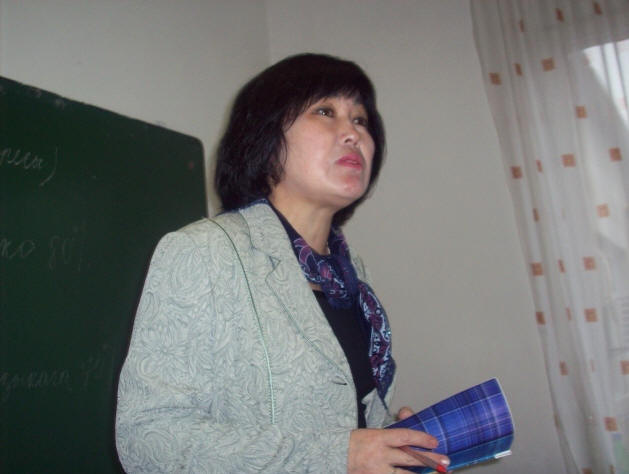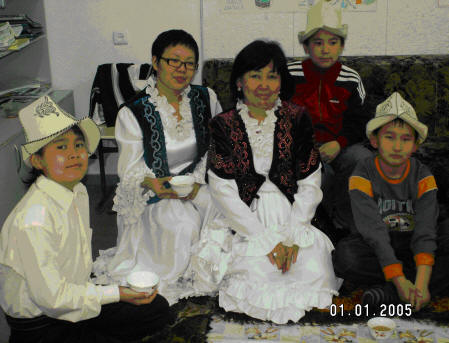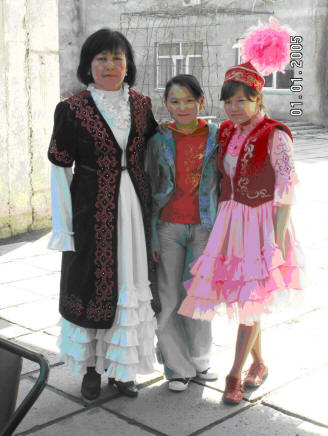|
How to teach in a multicultural
society? The teacher of English language, Bishkek, Kyrgyzstan. Nowadays we talk a lot about teaching in a multicultural society. Some scholars say that itís a very complicated task for a modern teacher. What should a teacher do to get better results in his/her activity? What should he or she teach first of all? Ahead of an ancient oriental holiday Nooruz, which is also a Moslem religious holiday and a national celebration of a lot of nationalities living in Kyrgyzstan, weíd like to talk about teaching Kyrgyz languages in our multicultural society. We are from Kyrgyzstan, a small independent state in the Central Asia. The official language of the country is Kyrgyz. Along with the official language Russian is widespread. A major part of people who live not far from the capital of Kyrgyzstan speak Russian language. The further they are from Bishkek the worse people speak Russian, they speak everyday Kyrgyz. To illustrate how we teach Kyrgyz, we have interviewed a teacher of Kyrgyz language, who has been working at school for more than 25 years. We also study the history of our country in Kyrgyz language. A few years ago I started a new elective course: Customs and traditions of Kyrgyz people. I tried to expand studentsí knowledge on the subject, to describe the difference in traditions of people living in the south, east, west and north of Kyrgyzstan, and also some common peculiarities. For example, people who live in the south have a different way of life from those who live in the north. It is because some historical, geographical and ethnical factors. Interviewer: Talking about ethnical conflicts do you have any problems of this kind in your own class? Saadat: All students in the class and at school are of different nationalities but with the same mentality. Thatís why in my school we donít have any multicultural conflicts. Well, we have some other problems with teenagers: intolerance to each other, misunderstanding things around them. To solve the problem I try to teach my students tolerance through friendly chat and role-playing. To close my students we often organize trips to the countryside, to some historical places. So it doesnít only join the student but also shows them round the country, its history and landscape. Interviewer: And where do you usually celebrate national holidays, do you go somewhere? Saadat: It depends. We mostly organize holidays at school. Itís a rather picturesque spectacle. On the 21-st of March we will celebrate Nooruz, this holiday symbolizes the beginning of spring. WeĎll dramatize various national traditions. Itís a good opportunity to practice spoken Kyrgyz and become familiar with |
 |
|
Welcome Saadat Sultanova, a teacher from school ďIlimĒ, Bishkek, Kyrgyzstan. Interviewer: Saadat, tell us, please what are the main tasks you have when you teach children of many different nationalities Kyrgyz language? Saadat: Frankly speaking, this work is very complicated. We have to teach in a multicultural environment. The plus is that almost all those students speak Russian, except of foreigners. So I teach Kyrgyz using the methodologies which are used in teaching foreign languages. The object I have is to teach students both fluent speaking and ability to express and prove their opinion, listen to a partner, prepare presentations and public appearance. We debate different issues. For example, recently we have discussed pluses and minuses of modern educational system. The students divided into two groups: one group proved the advantages of nowadays education, talked about the opportunities they have and their parents didnít. The other group said that their parentsí education was more qualitative than theirs. Anyway this debate had results. First of all the students persisted in their opinion and practiced spoken Kyrgyz. Interviewer: How do you uphold the discipline in class? I mean when the students debate itís hard to control the situation. Saadat: I do not have problems of this kind. If I have then I whether use a good joke or just keep silence and everything falls into place. Interviewer: Is it easier to teach Kyrgyz children their native language rather than students of other nationalities? Saadat: Not really. We work in the capital. And here live Kyrgyz people who think in Russian. They know only everyday Kyrgyz. I have to enrich their vocabulary first of all. So I can say that in my practice it doesnít matter what nationality a student is if he studies hard. Interviewer: Your task as a teacher is not only to teach spoken language. Saadat: Of course, not. Through our lessons we give the students access to following customs and traditions. In this world of modern globalization our new generation has already forgotten their roots. When children are in the fifth grade we start teaching them traditions. Itís a part of our curriculum. |
 |
|
We also study the history of our country in Kyrgyz language. A few years ago I started a new elective course: Customs and traditions of Kyrgyz people. I tried to expand studentsí knowledge on the subject, to describe the difference in traditions of people living in the south, east, west and north of Kyrgyzstan, and also some common peculiarities. For example, people who live in the south have a different way of life from those who live in the north. It is because some historical, geographical and ethnical factors. Interviewer: Talking about ethnical conflicts do you have any problems of this kind in your own class? Saadat: All students in the class and at school are of different nationalities but with the same mentality. Thatís why in my school we donít have any multicultural conflicts. Well, we have some other problems with teenagers: intolerance to each other, misunderstanding things around them. To solve the problem I try to teach my students tolerance through friendly chat and role-playing. To close my students we often organize trips to the countryside, to some historical places. So it doesnít only join the student but also shows them round the country, its history and landscape. Interviewer: And where do you usually celebrate national holidays, do you go somewhere? Saadat: It depends. We mostly organize holidays at school. Itís a rather picturesque spectacle. On the 21-st of March we will celebrate Nooruz, this holiday symbolizes the beginning of spring. WeĎll dramatize various national traditions. Itís a good opportunity to practice spoken Kyrgyz and become familiar with
|
 |
|
Kyrgyz culture. Interviewer: I can only add you have wide perspectives for creativity and wish you to have a bright festival and good luck. Saadat: Thank you. |